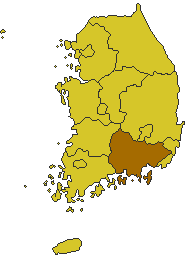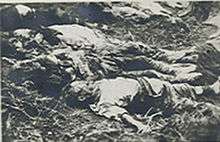Geochang massacre
| Geochang massacre | |
|---|---|
 South Gyeongsang, South Korea. | |
| Location | South Gyeongsang, South Korea |
| Date | 9 February 1951 - 11 February 1951 |
| Target | Communist sympathizer civilians |
Attack type | Massacre |
| Deaths | 719[1][2] |
| Perpetrators | Syngman Rhee anticommunist forces |

The Geochang massacre (Korean: 거창 양민학살 사건,[3][4] Hanja: 居昌良民虐殺事件) was a massacre conducted by the third battalion of the 9th regiment of the 11th Division of the South Korean Army between 9 February 1951 and 11 February 1951 of 719 unarmed citizens in Geochang, South Gyeongsang district of South Korea.[1][source needs translation][5][6] The victims included 385 children.[1][source needs translation] The 11th Division also conducted the Sancheong-Hamyang massacre two days earlier. The general commanding the division was Choe Deok-sin.[7][source needs translation]
In March 1951, Shin Chung-mok (ko), a leading assembly lawmaker from Geochang reported the massacre to the National Assembly against South Korean Army cover up.[2][5][8] The National Assembly's special investigation team investigated, but was hampered by the South Korean Army's interruption.[2][5] Shin was arrested and sentenced to death in an Army court martial.[8] In May 1951, the second investigation team was dispatched by the National Assembly and they reported the South Korean Army involvement.[5] After the investigation, Major Han and Colonel Oh Ik-gyun were sentenced to life in prison by a military court.[5] President Syngman Rhee subsequently granted clemency to criminals.[5] This massacre is pointed out as an example of oppression under his rule.[9]
In April 2004, the Geochang Massacre Memorial Park was founded in memory of the victims, in Geochang.[1][source needs translation][10]
On 20 February 2006, National Archives and Records Service reported the files about the massacre were found.[6]
In 2001, a local court ordered the South Korean government to pay reparations to the victims' families.[4][source needs translation] On 18 May 2004, a general court ruled that a charge of massacre against the South Korean governmental was barred by limitation.[4][source needs translation]
On 5 June 2008, the South Korean Supreme Court confirmed that the charge was barred by limitation.[3][source needs translation]
In June 2010, An jeong-a, a researcher for the Truth and Reconciliation Commission disclosed National Defense Ministry official documents on his thesis that the massacre had been done under official South Korean Army order in order to annihilate citizens living in the guerrilla influenced area.[11] On September 9, 2010, An was fired for disclosing Geochang massacre documents.[11] The National Defense Ministry accused An of disclosing the documents which he had been only permitted to view under the condition of nondisclosure.[11]
See also
- Truth and Reconciliation Commission (South Korea)
- Bodo League massacre
- Jeju Uprising
- Mungyeong massacre
- List of massacres in South Korea
| Wikisource has original text related to this article: |
References
- 1 2 3 4 편히 영면하소서!'..거창사건 희생자 위령제. Chosun Ilbo (in Korean). 2009-04-17. Archived from the original on June 11, 2011. Retrieved 2010-07-09.
- 1 2 3 Stueck, William. The Korean War in world history. Univ Pr of Kentucky. p. 45. ISBN 0-8131-2306-2.
- 1 2 대법 "거창양민학살사건 국가배상 책임 없다. Dong-a Ilbo (in Korean). 2008-06-05. Retrieved 2010-07-09.
- 1 2 3 거창양민학살사건 국가 배상의무 없다. Chosun Ilbo (in Korean). 2004-05-18. Retrieved 2010-07-09.
- 1 2 3 4 5 6 "SURVIVOR Hundreds were killed in a 1951 massacre. One man is left to remember.". JoongAng Daily. 2003-02-10. Retrieved 2010-07-22.
- 1 2 "Records throw light on modern Korea's history Detailed archival documents found at government offices". JoongAng Daily. 2006-02-21. Retrieved 2010-07-22.
- ↑ 산청 시천면 양민학살, 어떤 사건인가? 아녀자, 어린이 대부분...알려진 산청 함양사건과는 별개 출처 : 산청 시천면 양민학살, 어떤 사건인가? - 오마이뉴스. Ohmynews (in Korean). 2000-05-16. Retrieved 2010-07-18.
- 1 2 Stueck, William. The Korean War in world history. Univ Pr of Kentucky. p. 46. ISBN 0-8131-2306-2.
- ↑ "Outlook Remembering our father We have forgotten our founding father, the man who helped give birth to our democracy and its market economy. That is shameful.". JoongAng Daily. 2007-04-27. Retrieved 2010-07-22.
- ↑ "2008 외국어 관광안내표기 용례집" (PDF). Ministry of Culture, Sports and Tourism of the Republic of Korea. 2008. p. 28/278. Retrieved 2010-07-20.(Korean)(Chinese)(Japanese)(English)
- 1 2 3 ‘진실 공개’한 직원 내쫓은 진실위. Hankyoreh (in Korean). 2010-10-11. Retrieved 2013-04-06.
External links
- (Korean) 거창양민학살사건의 법적 해결 ― 관련법의 개정방안을 중심으로 Inseop Han SNU Center for Public Interest & Human Rights
Coordinates: 35°34′03″N 127°55′32″E / 35.56750°N 127.92556°E